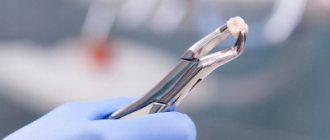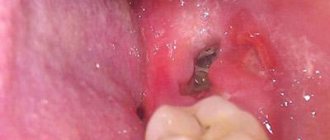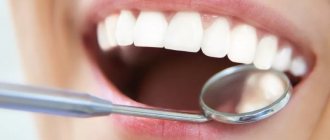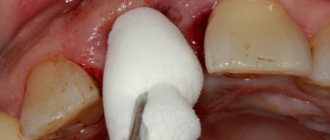How long does it take for gums to heal after tooth extraction?
Tooth extraction can be emergency or planned, but in each case healing occurs the same way.
Extraction of the organ is carried out when it is not possible to preserve the crown, in case of severe inflammation, or in advanced periodontal disease. The operation is performed under anesthesia, so there is no pain during removal. Unpleasant symptoms appear after the end of the dentist’s visit. The gums in the area of the removed organ hurt, but normally this goes away after seven days.
When the gums still hurt seven days after the tooth extraction is completed, and the inflammation does not subside for a long time, this indicates a complication. The most common consequences of organ extraction are alveolitis, bleeding, fracture, and injury to the socket.
How to relieve pain and inflammation?
The body experiences stress during surgery, so it is recommended to take a couple of days off to rest. Active pastime and stress are strictly prohibited.
To muffle the pain and relieve swelling, you should periodically apply a cold compress to the cheek for 15-20 minutes. The main thing is not to overdo it with cold, so as not to provoke inflammation.
In case of severe pain, it is necessary to take an anesthetic. If the pain intensifies on the second day, and the drug used does not have the desired effect, you need to contact the clinic.
If redness appears near the hole, the temperature rises, this means that the inflammatory process has begun. Anti-inflammatory drugs will help relieve it.
How many days does it take for the socket and gums to heal?
During a complex operation, the dentist may damage the jaw or push the tooth root into the maxillary sinus. If you do not seek help from a dentist for a long time with such complications, even more terrible conditions appear - gumboil, cyst, osteomyelitis.
Complete healing of the gums after tooth extraction occurs within several weeks. All this time, the mucous membrane hurts a little, but is simply anesthetized with local drugs.
The healing time of the hole is personal for each patient. Recovery takes a long time if care recommendations are not followed. The gums after tooth extraction do not heal even after a couple of weeks, if an infection was introduced during the operation or after the end.
The gum heals in 14 days, and complete restoration of the socket occurs in six months.
Tooth extraction: main stages
An obligatory stage is preparation for surgery. It includes a consultation and a three-dimensional photograph taken by the dentist, which allows you to assess the position of the tooth, the number and direction of the roots. Only after a thorough visual examination and diagnosis is an appointment for surgery made.
Surgery begins with local anesthesia, selected individually for each patient. In some cases, the operation consists of making an incision in the gum, sawing the tooth into several small parts and their subsequent removal.
Then sutures are placed and a fibrin clot, PRF, obtained by centrifuging the blood, is inserted into the socket, but the oral cavity requires special care even after surgery.
Why does the hole take a long time to heal?
Epithelization of the gums after the operation begins after a couple of days, and a white coating appears on it. Now it doesn’t hurt so much anymore, and there are no signs of inflammation. At this time, it is better not to touch the mucous membrane, but just continue to properly take care of the hole. It may not heal for a long time due to the patient’s personal quirks, at a time when there are diseases of the circulatory system or chronic inflammatory processes in the body.
If your gums hurt very badly after seven days, this is possible:
- Dry socket or alveolitis - this complication often appears when the rules for organ removal are not followed, while part of the crown or root remains in the socket. Under such conditions, the blood clot, which should protect against infection, falls out. This complication much more often begins on the 5th day after the end of the operation. Common symptoms are gum discoloration, unpleasant odor, halitosis, soreness, slight bleeding;
- Chronic bleeding - this complication is observed in people with hypertension and in the case of blood diseases. This may result in alveolitis. Before sending the patient home, the dentist stops the bleeding and places a hemostatic sponge on the hole;
- A fracture or dislocation of the lower jaw is a rare complication that occurs more often during the removal of a wisdom tooth; the risk increases if there is a cystic formation or acute inflammatory process in the root area;
- Perforation of the maxillary sinus is possible as a result of complex removal of chewing teeth in the upper jaw.
If the hole hurts for a long time, and it does not go away after seven days, you should immediately consult a doctor. It is forbidden to cope with complications that appeared during the removal on your own. Apart from this, there is no way to prevent them, so first aid is provided immediately after the procedure is completed.
Complications due to improper care, which slow down gum healing, can be prevented on your own.
Healing of the socket with gum inflammation
If tooth extraction was carried out against the background of inflammation, or the inflammatory process in the gums developed later, epithelization of the wound begins on the 10th -14th day, bone beams appear only by the 15th day. A significant part of the socket is filled with young osteoid tissue only by the end of the second month.
After a complex tooth extraction, when the gums rupture and the walls of the socket are traumatized, the edges of the gums cannot come together for a long time and the epithelization process slows down. Wound healing can only be completed after 1-1.5 months. In this case, the development of new bone tissue is delayed.
What to do after the extraction is complete
It is possible to realize that the hole is healing correctly on the 3rd day. The gums hurt moderately, and a white coating appears on it. It is extremely important not to remove it, since it is new epithelium. After 2 weeks, the onion should be completely covered with granulation tissue. After a month, bone tissue begins to regenerate in the entire socket. After 50 days, bone tissue fills the entire hole. And only after five to six months the hole is completely healed and does not differ from other bone tissue.
The gums will recover faster after tooth extraction is completed if you follow easy recommendations.
In the first days after surgery, minor bleeding may occur. Under such conditions, you need to take a small piece of cotton wool or gauze, soak it in hydrogen peroxide, and apply it to the hole. It is much better to go to the pharmacy immediately after removal and buy a hemostatic sponge. A small piece must be applied to the hole; it will dissolve on its own.
Factors affecting the rate of healing
Healing times may be longer due to the following factors:
- the age of the patient (the regeneration process is slower, the metabolism is disturbed), the wound healing process in people after 40 years is delayed by 1-2 weeks;
- immunity (weakened protective functions of the body provoke infection and rapid proliferation of microorganisms);
- the procedure is traumatic (injury to soft tissues in combination with the inept actions of the surgeon and the anatomical features of the roots leads to longer healing of the socket);
- infection of the socket after the removal of a single-rooted tooth delays the healing process for a week, for units with several roots - for 2-3 weeks;
- the location of the extracted tooth affects the quality of treatment with antiseptic agents; lateral molars are more difficult to clean from food particles, which provokes the formation of pathogenic microflora;
- oral hygiene (insufficient hygiene increases the risk of inflammation and secondary infection).
Do not rinse your mouth for the first 24 hours.
It is necessary to avoid warm foods and drinks, and not to take alcohol or blood thinners. It is possible to numb the wound with drugs such as Nimesil, Ibuprofen, Paracetamol. While brushing your teeth, you must avoid moving the bristles near the removed organ. If bleeding starts unexpectedly after a couple of days, you should immediately go to the doctor. This also applies to those cases when the pain is not relieved by simple analgesic and anti-inflammatory drugs.
On the third day, it is already possible to start rinsing the oral cavity with warm antiseptic solutions and herbal decoctions. This will speed up the healing of the hole and prevent inflammation and infection of the wound. For a couple more days you need to refrain from heat, sports, saunas, baths.
Some medications can have the opposite effect, leading to bleeding, so the medication must be coordinated with the dentist. Before removing the doctor, it is imperative to give a warning about concomitant and previous diseases. Tooth extraction has contraindications, and if they are missed, complications cannot be avoided.
Associated symptoms and what they indicate
Tooth extraction is a surgical procedure that involves tissue dissection. The operation itself is not complicated, but the anatomical features of the patient and his state of health make adjustments to the recovery process. It is recommended to monitor the situation based on symptoms.
| Symptoms during healing of the hole | |
| Name | What do they point to? |
| White hole | 1-2 days after the operation, the hole becomes covered with a white coating; this is a physiological process that does not cause concern. If a white spot forms at elevated temperature and pain, then alveolitis is often diagnosed based on a combination of symptoms. |
| Gums hurt | Non-increasing gum pain for 7-10 days is considered normal. If the pain intensifies every day and does not go away after the specified period, then it is likely that the infection is progressing in the body. |
| The gums are swollen | Swelling after surgery goes away within 3 days. The fourth day is a control day. If the swelling subsides, there is no cause for concern; in other cases, immediate assistance from a specialist is required. |
| Swollen cheek | If after surgery the swelling is small and there are no signs of its increase, then this is normal. If there is severe swelling that does not go away after 2-3 days, you should consult a doctor. The symptom may indicate the onset of inflammation or infection. |
| There's blood coming | The presence of blood after surgery should not be a concern. Discharge from the hole for up to half an hour is normal. Sometimes, due to the characteristics of the body, this period extends to two hours. If the bleeding does not stop, then the reasons may be the following: damage to blood vessels during manipulation, the onset of an inflammatory process, poor blood clotting, the effect of blood thinning drugs. |
| The temperature has risen | If after tooth extraction there is an increase in temperature to 37.5° on the first day, there is no need to be afraid. With further deterioration of health, this symptom indicates infection of the wound. |
When to see a dentist
A visit to the doctor should not be delayed in the following cases:
- Initially or after a couple of days, a blood clot falls out;
- A purulent lump appears in the area of the hole;
- The pain does not go away for a long time and inflammation appears;
- The entire jaw begins to ache, radiating to the temple and eye areas;
- There is a constant iron taste of blood in the mouth;
- Pain appears in the area of the adjacent tooth;
- Within 5 days the gums are not covered with white plaque.
If you are worried about your teeth, you will be helped at the Doctor-RAF Dental Clinic (Almaty, Muratbayev St., 101). Our highly qualified specialists will help you solve all your dental problems.
During the operation, a neighboring organ may be damaged. This will manifest itself as symptoms of pain, and perhaps the tooth will begin to loosen.
Complex removal will require additional care and the use of bactericidal drugs, but only those prescribed by the dentist. Self-prescribing antibiotics is prohibited. An exception would be local gels and ointments, which are available without a prescription and have an anti-inflammatory effect.
8 reasons why the hole does not heal after tooth extraction, ways to speed it up.
After tooth extraction, it seems that the worst is over. However, this is a surgical operation that does not exclude the possibility of complications, especially if you do not follow the doctor’s recommendations. What to do when the hole does not heal?
When to see a doctor
The sooner you see a doctor if you notice signs of inflammation, the easier and faster the problem can be solved. Since, in the normal course of events, pain and swelling disappear within 2-3 days, a good reason to urgently consult a dentist would be an increase in the symptoms present a couple of days after removal. The absence of a clot in the hole, swelling of the tissues, increasing pain and a suspicious-colored coating are the main signs indicating undesirable processes. In such a situation, you cannot hesitate - you need to immediately go to the doctor.
- According to WHO.
Healing process
The stages of wound healing are as follows:
- The first day: the hole fills with blood, which turns into a clot due to coagulation. It becomes the basis for bone formation in place of the void, and also protects against infection.
- 3-4 days: the clot is replaced by granulation tissue. By this time, the severity of pain decreases, and sometimes the area of surgery stops hurting completely.
- Week: a clot remains inside the socket, but most of it has already been replaced by granulation tissue.
- Two weeks: the wound is filled with granulation tissue, turning into bone along the edges and bottom.
- 2-3 months: the hole completely turns into bone.
In order for recovery to occur correctly, you must follow all the doctor’s recommendations.
Stages of socket regeneration
How long does it take for damaged soft gum tissue to heal? It all depends on the individual characteristics of the human body. Regeneration time varies widely - from several weeks to several months. The healing period depends on the complexity of the dental work performed, the type of unit removed (soft tissue takes a long time to heal after the removal of wisdom teeth and elements with a large number of roots), the presence of chronic and infectious pathologies.
How does the hole heal after tooth extraction? There are several stages of healing:
- Formation of a blood clot (after 2-4 hours). At this time, it is advisable to refrain from rinsing the mouth and eating food. Injury to the clot leads to infection of the soft tissues of the gums and the development of alveolitis.
- The stage of formation of granulation tissue 2-3 days after the intervention. This tissue is the basis for the growth of new epithelium.
- The formation of the epithelium begins on days 7-14 after the intervention.
- Formation of the bone tissue of the socket from the edges to the center - 2-3 weeks.
- Mineralization of osteoid – 21 days from the moment of surgery.
- Calcification of bone trabeculae – after 2-3 months.
Stages of socket healing
How long does it take for gums to heal? The answer to the question depends on the volume of damaged tissue. If the doctor had to apply stitches during the intervention, then gum regeneration can be observed only after a week. Complete tissue restoration is observed only after 3 weeks, at the moment when the formation of new bone tissue begins.
After removing the figure eight, the gums will heal only after a month. This fact must be taken into account so as not to waste time fighting natural symptoms. Stress will only slow down the recovery of the extracted tooth socket.
In normal condition, the wound stops bleeding 3 days after extraction. The clot changes its color from burgundy to light or yellowish. This condition is explained by natural physiological processes: gradually saliva washes away hemoglobin from the clot, leading to its discoloration. Despite the change in color, the clot retains its structure and prevents re-bleeding and infection of the socket.
Do not clean the injured area with a brush or touch it with your hands. Failure to comply with these conditions and the dentist’s recommendations may lead to suppuration of the wound and formation of gumboil in the gums. One of the most common consequences of the removal of multi-rooted teeth is alveolitis, manifested by severe pain and inflammation of the operated area. If timely measures are not taken, the disease can be complicated by phlegmon, sepsis and abscess.
Lightening the hole after tooth extraction by 4-5 days
After 5 days, the wound will regenerate, but the patient will experience discomfort for several more days when eating food. If there is no severe pain, then a repeat visit to the dentist is not required. At this time, it is important to thoroughly clean the oral cavity and try to chew food on the healthy side of the jaw.
How many days does it take for the pain to disappear? This is usually observed on day 7-8. Granulation tissues gradually replace the blood clot. Only in the middle of the wound are epithelial particles observed. If by this time the pain does not subside, you should immediately consult a doctor. It may be necessary to re-open the cavity and rinse it with antiseptics. In practice, complications are rarely observed in patients who follow preventive rules after extraction.
What does the wound healing process depend on? Several factors should be noted:
- Age and immune system of the patient. At a young age, the wound heals faster due to accelerated metabolism. In elderly patients, the socket scars for several weeks longer, which is considered normal.
- Type of element to be removed. The hole after the removal of a wisdom tooth is much larger and deeper than after the extraction of other elements. With complex removal of the figure eight, regeneration of soft tissues is observed only on days 7-8. Gums heal worst after removing elements with crooked roots and crumbled crowns.
- Possibility of infection. The main sign of the pathological process is redness and inflammation of the surgical site. After removing a single-rooted tooth, the sign should disappear on the 5th day, after removing units with numerous roots - on the 13th day.
- Oral care. After the operation, the specialist advises the patient about the features of the rehabilitation period, which include rinsing (from day 3), changing the diet, and careful oral care. It is especially important to adhere to preventive measures after extraction of the lateral elements.
To accelerate the regeneration of soft gum tissue, ordinary and cosmetic sutures are used. In the first case, the patient will need to return to the dentist for suture removal. Cosmetic materials dissolve independently in the oral cavity.
Why doesn't the hole heal?
The timing of wound healing is an individual question. It is determined by several factors - the traumatic nature of the removal, the presence of postoperative sutures, and the age of the patient. It is believed that partial epithelization takes about 2 weeks, complete - up to two months. These deadlines may increase for the following reasons:
- The bone was severely damaged. This happens, for example, during a complex extraction, when the tissue around the tooth has to be cut out with a drill.
- The clot has fallen out, so there is no basis for the formation of granulation tissue.
- Due to the doctor's fault, bone fragments remained in the wound.
- The patient ignores the recommendations received. The most common mistake is rinsing out the clot, after which an infection from the oral cavity gets into the wound.
- The mucous membrane around the wound is mobile, and no stitches were applied.
- Carious remains entered the cavity and inflammation began.
- The surgeon did not take into account individual characteristics. For example, with arterial hypertension, heavy bleeding begins, so drugs that lower blood pressure are additionally prescribed.
- Old age of the patient.
Gum healing time
Conventionally, dentists divide the regeneration process into two stages - partial, complete. Partial epithelization is said to occur in the first 12 days after tearing out, and complete epithelialization occurs after 20-25 days. But with complex removal, leading to significant damage to bone tissue and muscles, the recovery period may increase by several more days.
Among the most common reasons causing slow epithelization:
- significant trauma to bone tissue and gums during the intervention (especially if the bone around the diseased tooth was cut out with a drill);
- the occurrence of alveolitis of the inflamed socket;
- damage to the protective clot or its unformation (“dry” hole);
- incomplete removal of bone fragments due to the doctor’s carelessness;
- mobility of the mucous membranes, which needed to be sutured, but for some reason the surgeon decided not to suture;
- refusal to use antibiotics during a severe recovery period;
- diabetes;
- reduced immunity.
Ways to speed up healing
The best thing a patient can do to speed up epithelialization is to create conditions in the oral cavity that are close to sterile. To do this, you must follow some rules:
- Squeeze the cotton swab applied after surgery tightly with your teeth for 15-20 minutes.
- Do not eat for 3 hours so as not to interfere with the clot formation process.
- In the first days, do not smoke, give up alcohol and solid food.
- Avoid heavy physical activity, temperature effects (hot drinks and dishes, trips to the bathhouse, sauna).
- Do not chew on the injured side for two days.
- Avoid rinsing and use chlorhexidine baths instead.
- Take prescribed medications - for example, antibiotics, which are prescribed after a complex removal, in the presence of purulent processes.
- After consulting with your doctor, use Solcoseryl, a gel that helps accelerate epithelization.
It is important to remember that the area where the deletion took place is a very vulnerable place. The mouth is home to a large number of opportunistic microorganisms, which, in the presence of a source of bleeding, become pathogenic, triggering the inflammatory process. To perform the operation, you should choose an experienced surgeon and strictly follow his recommendations after the procedure.
How to speed up the healing of a hole
To speed up the healing of the hole after tooth extraction, you need to follow these rules:
- Do not touch the blood clot on the socket with your tongue, much less with your hands or a toothpick, so as not to damage it. The presence of a clot is a guarantee of speedy healing of the wound.
- For three hours after visiting the dentist, you should not eat or rinse your mouth. Compliance with this point will also help maintain the integrity of the blood clot.
- · Drinks and food should not be too hot or cold for several days after removal. The food chosen is soft, without coarse inclusions, to prevent injury to the gums.
- You should not engage in heavy physical work for several days to avoid opening the wound and resuming bleeding.
- Since tobacco smoke and alcohol irritate the mucous membrane and inhibit the healing of the hole, you need to stop smoking and drinking alcohol for a while.
- To prevent infection from entering the wound and reduce inflammation after a traumatic tooth extraction, antiseptic baths are used. For them, solutions of chlorhexidine or furatsilin, infusions of sage, chamomile, and eucalyptus are used. The solutions are taken into the mouth, held for several minutes and carefully spat out.
- On the third day after removal, you can carry out antiseptic rinses with the same agents.
- Taking anti-inflammatory drugs (nimesulide, ibuprofen) will help not only eliminate pain, but also relieve the inflammatory process, which also helps accelerate socket regeneration.
- If the doctor has prescribed antibiotics, you should not refuse them, since eliminating the microbial infection shortens the healing time.
- When brushing your teeth, be careful not to touch the wound with the brush.
- To speed up healing, you can use Solcoseryl dental paste. It enhances intracellular energy exchange, due to which cell regeneration and restoration of damaged tissues are accelerated. Solcoseryl also creates conditions for the growth of granulation tissue. The paste is applied to a previously dried surface, then moistened with water. Before using the medicine, it would be more correct to ask your dentist about when to start using Solcoseryl after tooth extraction and how many times a day to apply it to the gums.











